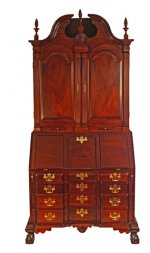Antiquity
Well-known member
(For some reason I am having trouble posting. This is my 3rd attempt. Each time it says it was successful but nothing is there. Sorry if it is there 3 times.)
A Salem, MA mahogany secretary or desk and bookcase I recently completed. The blocked lid is carved from one piece of wood as well as the four lower drawers. The arched doors are flanked by fluted columns with a candle slide under each door. The panels are book matched. In the upper section scalloped dividers form 19 cubby compartments. Two concave ribbed shells are behind each door. There are 31 drawers total with 16 hidden drawers or compartments. Some compartments require two special tools to open. 95H x 46W x 25D.
(In this hi-tech world I don't understand why we can only post 165 KB in each posting. So I must post open and closed separately.)
Dennis Bork
Antiquity Period Designs, Ltd.
A Salem, MA mahogany secretary or desk and bookcase I recently completed. The blocked lid is carved from one piece of wood as well as the four lower drawers. The arched doors are flanked by fluted columns with a candle slide under each door. The panels are book matched. In the upper section scalloped dividers form 19 cubby compartments. Two concave ribbed shells are behind each door. There are 31 drawers total with 16 hidden drawers or compartments. Some compartments require two special tools to open. 95H x 46W x 25D.
(In this hi-tech world I don't understand why we can only post 165 KB in each posting. So I must post open and closed separately.)
Dennis Bork
Antiquity Period Designs, Ltd.

